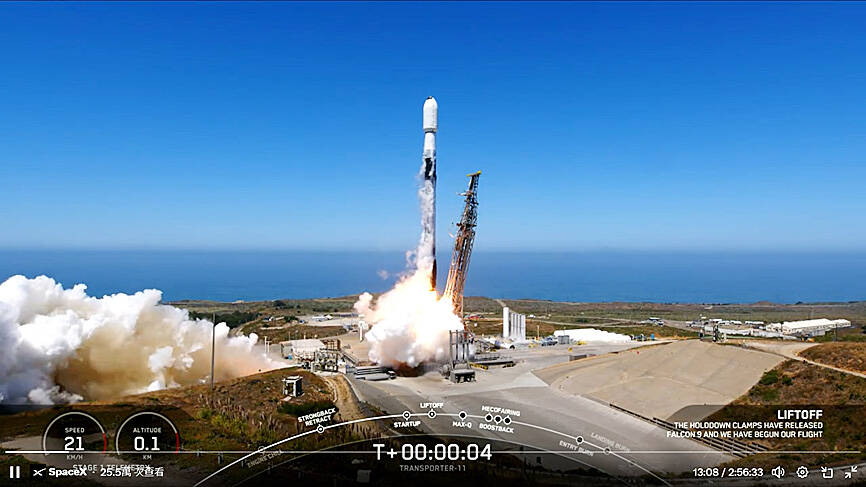A Space Exploration Technologies Corp (SpaceX) Falcon 9 rocket on Friday carried two Taiwan-developed satellites into orbit, along with 114 others, the Taiwan Space Agency (TASA) said.
The two “cube satellites” or CubeSats — Toro and Nightjar — were launched into space at 11:56am from Space Launch Complex 4E at Vandenberg Space Force Base in California on the Transporter-11 rideshare mission, TASA said.
Toro and Nightjar entered orbit at about 2:30pm, the agency said.

Photo: Screen grab from livestream via the Taiwan Space Agency
CubeSats are a class of small satellites made up of multiple cubic modules each measuring 10cm on a side and weighing up to 1.3kg that have a wide range of applications and are increasingly relevant in the aerospace industry.
Toro and Nightjar are both 30cm by 10cm by 10cm, TASA said.
Compared with traditional satellites, the CubeSats business has a relatively low entry threshold in terms of cost and technology. As they are smaller and lighter, a rocket is able to carry many CubeSats at the same time, making them a good option for those in the private sector wanting to enter the aerospace industry.
Toro, which was developed by satellite communications product supplier Pyras Technology Inc (芳興科技), carries a payload of cameras that are to photograph the ocean over four hot spots in the equatorial region to analyze changes in the water’s color and enable the completion of fishing ground positioning, TASA said.
Thanks to Toro, Taiwan’s aerospace technologies are expected to serve the country’s fishing industry well, using positioning technologies, marine communications and fleet management, as Pyras Technology has worked hard conducting field surveys in oceans to meet market needs, the agency said.
Toro is expected to help the fishing industry find ocean resources, it added.
Pyras Technology has been working on developing satellites, such as Formosat-1, with TASA since the 1990s, when it was called the National Space Organization, the agency said.
Pyras Technology has also worked with foreign space and military organizations to develop satellite components, TASA said.
Nightjar, developed by antenna designer and radio frequency testing manufacturer Rapidtek Technologies Inc (鐳洋科技), carries a payload of Ku-band high-speed Internet of Things communications services, and its mission is to test communication links between satellites and fixed user terminals or high-speed moving user terminals on the ground, TASA said.
If the two CubeSats work well and get certified, it would open the door for Taiwan to develop satellite engineering and compete in the commercial aerospace industry, it said.
TASA in 2022 launched a 10-year satellite innovation program focusing on the development of CubeSats. The program has four phases. Pyras Technology and Rapidtek Technologies are part of the second phase of three years, which started last year. The first phase was a one-year preparation phase. The third and fourth phases are to last three years each.
The two companies and Tron Future Tech Inc (創未來科技), which provides active electronically scanned array technologies for communications equipment, are developing larger CubeSats that are 40cm by 20cm by 20cm.
The launch of the first of these CubeSats is scheduled for next year, TASA said.

CALL FOR SUPPORT: President William Lai called on lawmakers across party lines to ensure the livelihood of Taiwanese and that national security is protected President William Lai (賴清德) yesterday called for bipartisan support for Taiwan’s investment in self-defense capabilities at the christening and launch of two coast guard vessels at CSBC Corp, Taiwan’s (台灣國際造船) shipyard in Kaohsiung. The Taipei (台北) is the fourth and final ship of the Chiayi-class offshore patrol vessels, and the Siraya (西拉雅) is the Coast Guard Administration’s (CGA) first-ever ocean patrol vessel, the government said. The Taipei is the fourth and final ship of the Chiayi-class offshore patrol vessels with a displacement of about 4,000 tonnes, Lai said. This ship class was ordered as a result of former president Tsai Ing-wen’s (蔡英文) 2018

‘SECRETS’: While saying China would not attack during his presidency, Donald Trump declined to say how Washington would respond if Beijing were to take military action US President Donald Trump said that China would not take military action against Taiwan while he is president, as the Chinese leaders “know the consequences.” Trump made the statement during an interview on CBS’ 60 Minutes program that aired on Sunday, a few days after his meeting with Chinese President Xi Jinping (習近平) in South Korea. “He [Xi] has openly said, and his people have openly said at meetings, ‘we would never do anything while President Trump is president,’ because they know the consequences,” Trump said in the interview. However, he repeatedly declined to say exactly how Washington would respond in

WARFARE: All sectors of society should recognize, unite, and collectively resist and condemn Beijing’s cross-border suppression, MAC Minister Chiu Chui-cheng said The number of Taiwanese detained because of legal affairs by Chinese authorities has tripled this year, as Beijing intensified its intimidation and division of Taiwanese by combining lawfare and cognitive warfare, the Mainland Affairs Council (MAC) said yesterday. MAC Minister Chiu Chui-cheng (邱垂正) made the statement in response to questions by Democratic Progressive Party (DPP) Legislator Puma Shen (沈柏洋) about the government’s response to counter Chinese public opinion warfare, lawfare and psychological warfare. Shen said he is also being investigated by China for promoting “Taiwanese independence.” He was referring to a report published on Tuesday last week by China’s state-run Xinhua news agency,

‘ADDITIONAL CONDITION’: Taiwan will work with like-minded countries to protect its right to participate in next year’s meeting, the foreign ministry said The US will “continue to press China for security arrangements and protocols that safeguard all participants when attending APEC meetings in China,” a US Department of State spokesperson said yesterday, after Beijing suggested that members must adhere to its “one China principle” to participate. “The United States insists on the full and equal participation of all APEC member economies — including Taiwan — consistent with APEC’s guidelines, rules and established practice, as affirmed by China in its offer to host in 2026,” the unnamed spokesperson said in response to media queries about China putting a “one China” principle condition on Taiwan’s